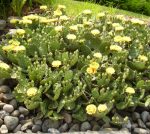
Also called devil’s-tongue and Indian fig, this perennial cactus is native to eastern US from coastal Connecticut to the Florida Keys west to the lower Great Lakes, to the dry areas of Montana and south to New Mexico, where it grows in open areas with sandy, rocky, scrubby habitats. It is a member of the cactus family, Cactaceae, that is in the classification order that also includes carnations, ice plant, and beets. Plants grow 6-12″ tall and spread horizontally and have flattened green stems composed of oval to oblong paddle-like segments 2-6″ long with barbed bristles and sometimes long spines on the edges. From late spring to early summer, bright yellow waxy flowers with 8-12 petals, sometimes with red centers, appear along the margins of the pads and are 2-3″ wide. They vary attractive to a variety of pollinators and give way in the fall to green to purple oval fruits up to 2″ long that are edible but not flavorful. Eastern prickly pear is a good choice for a groundcover, xeriscape, and desert, native plant, and wildflower garden. The genus name, Opuntia, is the Greek name for another plant that grew in ancient Greece. The specific epithet, humifusa, comes from the Latin words humus meaning ground, and fusus, meaning fell down, and refers to the sprawling nature of the plant.
Type: Perennial cactus
Bloom: Bright yellow flowers sometimes with red centers, 2-3″ wide, from late spring to early summer
Size: 6-12″ H x 12-18″ W
Light: Full sun
Soil: Average, dry to medium moist, well-drained
Hardiness: Zones 5-10
Care: Low maintenance
Pests and Diseases: None of significance
Propagation: Stem cuttings, seed
Companion Plants: Aloe maculata, yucca, green Mormon tea
Photo Credit: Wikimedia